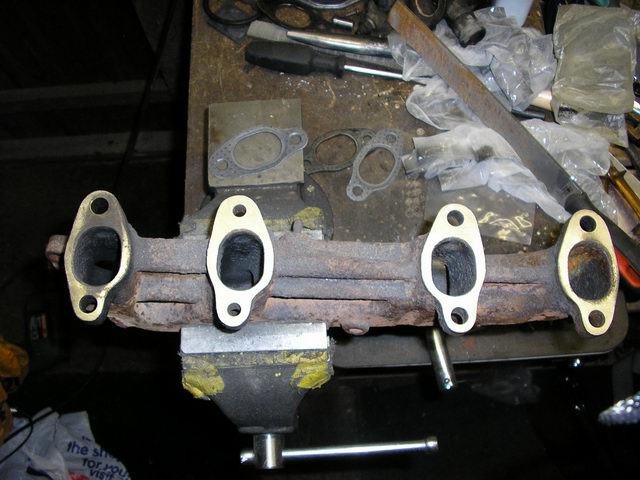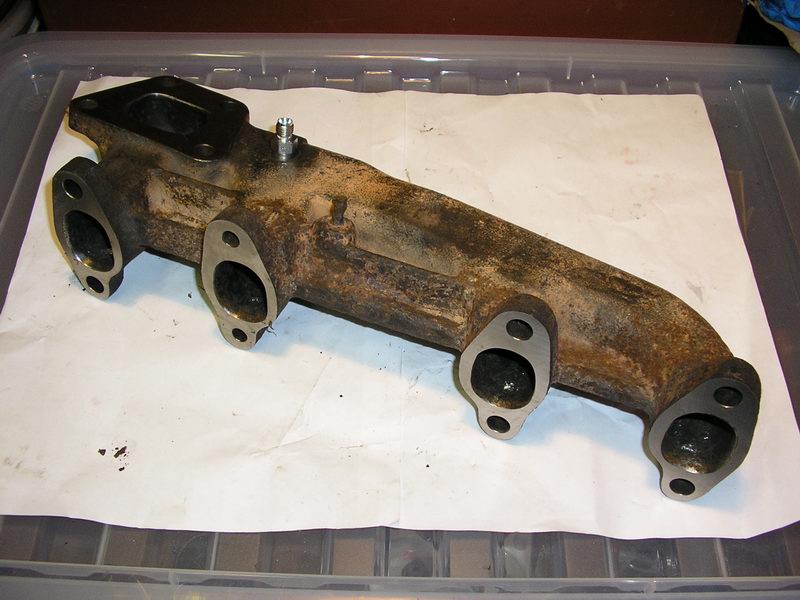Techniques - Cleaning/Trueing mating faces
It's often necessary to clean up and flatten surfaces on engine parts, for good fitting or sealing purposes.
Exhaust flanges and thermostat housing faces both come to mimd, anything that takes a flat type of gasket
really needs to be as flat and true as possible first. There are parts on a Turbo's exhaust
that must form a pressurised gastight seal, yet without a gasket being available.
Introducton
There are times when mating surfaces have to be just that - mating to high degree of accuracy. One example would be that of a valve seat face and the corresponding seat itself, attained quite easily using carborundum grinding paste. A harder one to achieve is a really flat face, on a part that is perhaps large, heavy or oddly shaped. In a proper engineering refurb shop, these would often be machined in one way or another e.g. a cylinder head - ground or milled flat; a flywheel face - usually ground on a special machine due to its hardness, or a round part trued-up on a lathe. Failing such facilities, what follows are a few tips on how small to medium sized parts can be surfaced or at least given improved flatness and finish.
Finding flatness
Often the best and quickest way is to start to clean and flatten the surface somehow, where quite soon any high-spots or irregularities will become apparent and usually, you won't be doing any harm. First though, if there's any thick rust, scale or gasket on the surface, use an engineering flat scraper to remove it See: Engineering scrapers.
An engineers straight edge or steel rule and a good eye in good light can often show up a few thou out-of-true or engineers blue can be used between two surfaces, either those that mate in practice, or each one against a known true flat one e.g. a surface plate, or good substitute. Any rust or pitting will show up immediately in outline and wherever securing holes are present (e.g. stud holes), high spots will usually exist around them.
Good substitute for an engineers surface plate... a foot square or more of thick plate glass. Whilst glass flows plastically, old plate glass is usually pretty rigid and true, particularly if kept horizontal on another good flat surface. It has the advantage in that it can double as a surface for using carborundum grinding paste over a large area, or Emery paper, should it be necessary.
Another useful surface is that of a thick chopping block, of the type where the wood grain runs in the direction of thickness. Made of fairly stable wood (beech would be good), these are often of fair flatness, but check with your steel rule first.
Then there's plate steel (not sheet) and ally, of 1/8" up to 1/2" being practical - always check it with a steel rule both ways. Deburr edges. Thinly spray glue, wait a mnute and apply Silcion Oxide, Alumnium Oxide or Emery paper. Trim off excess at edges with a hook bladed Stanley knife.
Steps to get a flat, clean surface
If you are skilled with a file, a bastard or 2nd cut can often be used to ensure a flat surface, but can do more harm than good in a few seconds in the wrong hands.]
A more reliable way, once any heavy rust scales have been chipped away General Engineering Scrapers, is to use a dead flat surface such as a sheet of plate glass, a thick surface-ground steel plate, or a piece of kitchen worktop (good thick smooth gloss finish) and a new sheet of 80~120 grade emery paper (with a thin but even layer of spray glue). Care must be taken to at no time 'rock' the mating surface, just hold it very firm and move it along and back a few times, and then both diagonal directions - clean paper with wire brush or just vacuum it every time you see a buildup within the grit, vacuum up job and repeat. It may take time (image below) but you'll have done as good as you can without a machine shop to take the high-spots off. Spray-glue can be cleaned off with white spirit before applying a new sheet; vacuum every minute or so when paper becomes clogged blocked. Aluminium Oxide or similar is good stuff, and with the finer grades, 3-in-1 oil can be used to finish, preventing rapid corrosion of a freshly ground surfacein damp atmospheres.
The outer two ports were originally about 0.030" below the two middle ones. Picture taken about halfway finished (a couple of hours here and there!) - its now about perfectly flat all over with burnt areas removed - that was another two or three hours - obviosuly a machine shop could get this level and flat with a grinder or fly cutter quite quickly - if one is nearby and tame - it wasn't... Cast iron is slow work over this sort of area with high distortion, but with a long thick flat steel using 40 grade, then 80 and 120, a good result can be had. Straight strokes then alternately at 45/45 or right angles are best. Vacuum de-dust frequently to extend life of flatting paper almost indefinitely.
Finally
Whenever using carborundum paste, emery or sandpaper, work as clean as possible and brush/vacuum up behind yourself - there is no place I know in an engine for it! Try to do this work in a separate area, maybe even outside on a bench.
Coarse Emery paper (120 and down) and files can be cleaned using a wire brush or file card. A good stainless wire brush is a handy thing to have. Running a powerful vacuum cleaner's nozzle over emery paper removes most of the blocking dust in seconds - gets it cutting again. Blowing it around with compressed air - not a good idea!
A very densely packed brass brush is excellent for cleaning a file after using a normal file-card, especially to remove any light surface rust (heavy rust totally blunts a file, never get them wet). A very thin (modelling knife) blade is also useful for picking out file grooves when its been blocked (a too fine file used harshly on aluminium for instance)
Steel rust itself is pretty abrasive, even the dust from it - stop and clean often and take care, especially with your eyes.
HarryMann

